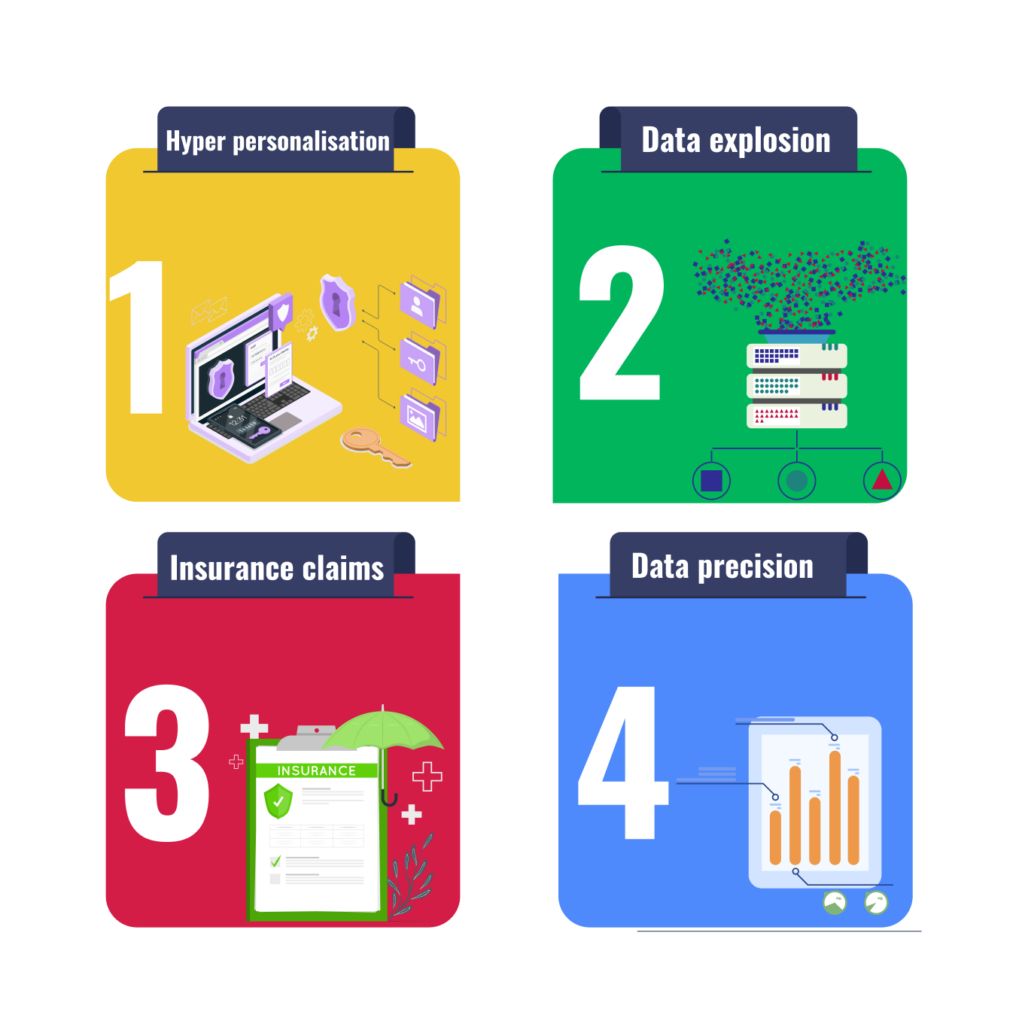
In the ever-evolving domain of insurance, a technological force is redefining the landscape, reshaping the core principles of underwriting, risk management, and claims processing. Introducing Artificial Intelligence (AI), a groundbreaking innovation that has captivated the insurance sector, driving it toward unparalleled levels of efficiency.
According to Forbes, operational efficiency has surged by an impressive 60%, accompanied by a staggering 99.99% improvement in claims accuracy.
The allure of AI in insurance extends beyond statistics—it has a projected value of USD 35.77 billion by 2030, with a compelling CAGR of 33.06% (Global AI in Insurance Market 2023-2030). This surge represents more than mere numbers; it signifies a paradigm shift from reactive approaches to proactive strategies, redefining the roles of insurers, brokers, and consumers.
However, amid the tangible benefits and cost savings, the industry grapples with fully realizing the potential of AI, as revealed by the absence of AI Achievers among insurers.
This blog dissects the profound impact of AI on insurance, navigating the promises, pitfalls, and the transformative path that lies ahead.
How can AI add value to the insurance industry?
1. Streamlined claim processing with AI
Traditionally complex and time-consuming, insurance claim processing sees a paradigm shift with the integration of Artificial Intelligence (AI). AI, alongside technologies like Robotic Process Automation (RPA) and the Internet of Things (IoT), automates tasks, reducing errors and expediting processing times.
The incorporation of IoT devices, from smart home assistants to fitness trackers, enables seamless data collection, fostering enhanced connectivity with policyholders and informing decisions in underwriting and claim management to reduce risks.
2. Revolutionizing risk assessment with AI
The underwriting process, traditionally reliant on manual data entry, transforms with AI. Increased connectivity and IoT device utilization contribute to extensive datasets for precise risk assessment. Natural Language Processing (NLP) amplifies insurers’ ability to evaluate risk by extracting pertinent information from diverse sources.
AI in underwriting demonstrates exceptional accuracy, including an 83% precision in modeling potential markets, a tenfold reduction in underwriting throughput time, and a 25% enhancement in case acceptance. These advancements underscore AI’s capability to leverage diverse datasets for more accurate risk evaluation.
3. Fraud detection and prevention
Fraud within the insurance industry encounters a formidable solution in AI. Through the analysis of extensive datasets, AI identifies suspicious patterns in real-time, empowering insurers to mitigate risks, minimize financial losses, and uphold operational integrity.
The substantial cost of non-health insurance fraud, estimated at over $40 billion annually, highlights the urgent need for robust fraud detection mechanisms. AI emerges as a game-changer in this realm, offering real-time analysis to pinpoint potential fraud, ultimately protecting policyholders from deceptive claims.
4. Innovating claims reporting and Management with AI
AI’s impact extends beyond mere claim processing to encompass the entire lifecycle of claims. AI-enabled chatbots facilitate efficient claims reporting, providing customers with a seamless experience across devices and locations. Moreover, AI and machine learning streamline claims management processes, optimizing operations and reducing costs.
The integration of AI in claims management allows for the handling of the first notice of loss with minimal human intervention. AI-driven chatbots play a pivotal role in automating reporting, routing, triaging, and assigning claims, ensuring a quick and error-free experience.
5. Redefining underwriting processes with AI
Underwriting, a pivotal aspect of the insurance industry, undergoes a transformative evolution with the integration of AI. The digitalization of existing touchpoints and access to new data assets empower insurers to convert data into actionable insights for more tailored coverage and pricing.
AI techniques, such as supervised learning, complement and streamline underwriting processes, enhancing the ability of insurers to offer customers personalized coverage and pricing. The integration of AI models into automated underwriting platforms exemplifies the collaborative potential of human expertise and machine intelligence.
6. Innovation in claims with AI
AI capabilities not only enhance efficiency in claims processing but also pave the way for innovative solutions and coverage for previously uninsurable risks. Examples like Swiss Re’s parametric Flight Delay Compensation, built on an AI model predicting flight delays, showcase the transformative potential of AI in offering instant payouts without the need for manual claims filing.
AI’s integration with computer vision introduces novel approaches to claims assessment, such as reducing car accident fraud and detecting driving styles. This convergence of edge computing and AI positions insurance at the forefront of technological innovation, aligning with evolving industry needs.
AI-driven trends that are driving the insurance sector

1. Hyper-personalization
AI is a potent force driving hyper-personalization in the insurance sector. Sophisticated algorithms empower insurance companies to tailor policies and products precisely to each customer’s unique needs. By analyzing lifestyle, behavior, and preferences, AI facilitates a crucial level of personalization essential for customer attraction and retention in today’s competitive market.
2. Data explosion from connected devices
The surge in connected devices brings forth a massive influx of data within the insurance industry. IoT sensors and smart devices generate vast volumes of information, presenting both challenges and opportunities. Effectively managing and analyzing this data is crucial for insurers aiming to stay competitive in the digital landscape.
3. Extended reality in insurance claims
Extended reality (XR) emerges as a game-changer in insurance claims processing. AI technology allows virtual assessments post-claim filing, eliminating the need for the physical presence of the insured object. This not only streamlines the claims process but also enables more accurate quotes based on the safety features of the insured vehicle.
4. Data precision
In the realm of AI, precision in data is paramount. The ability to collect accurate data from diverse sources is intrinsic to AI technology. For insurers, ensuring the precision of data becomes crucial for proactive risk mitigation and fraud prevention, contributing to better-informed business decisions.
How AgiraSure can help?
AgiraSure specializes in bespoke technology solutions for mid-sized P&C insurers in the US and general insurers in Asia and Africa, ensuring digital transformation and sustainable growth.
Consulting for success
AgiraSure provides strategic consulting, providing solutions that address unique challenges for mid-sized P&C insurers. From gap analysis to solution approaches, we create roadmaps for future-ready capabilities.
Modernizing legacy systems
Choose stability with our ‘RTI or run the insurance’ or embrace modernization with the ‘CTI or Change the insurance.’ AgiraSure’s options like retire, rehost, re-platform, refactor, and relocate ensure near-zero downtime.
Accelerators & partner solutions
Enhance engagement with our contact center, streamline subrogation with blockchain, leverage analytics, simplify document management, and facilitate claims filing and underwriting decisions through innovative solutions.
Benefits of AgiraSure
– Predictability and transparency
– Rapid go-to-market
– Scalability for business growth
– Enhanced customer experiences
– Best practices through CPCU & Institutes
– Effective risk management
– Intelligent data utilization for a boosted bottom line.
Conclusion
In conclusion, artificial intelligence’s integration into the insurance sector heralds a paradigm shift. From streamlined claims processing to enhanced risk assessment and fraud prevention, AI fosters efficiency and profitability. The industry stands at the brink of a transformative era, where data-driven decision-making and hyper-personalization redefine the insurance landscape, promising a future where innovation and technology converge to elevate customer experiences and industry practices.







